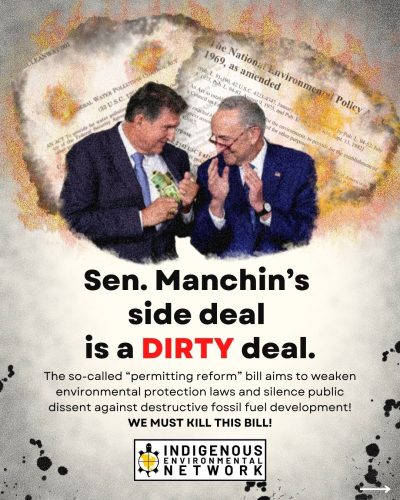
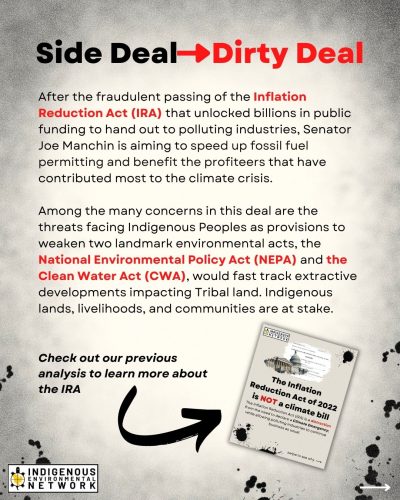
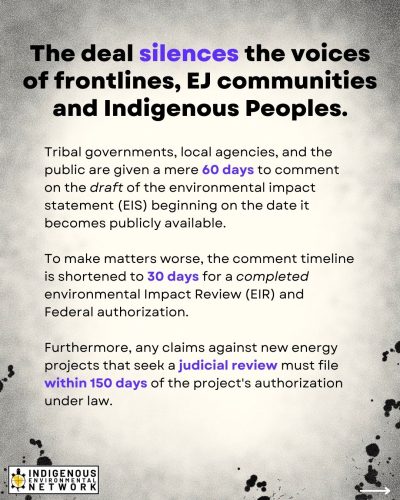
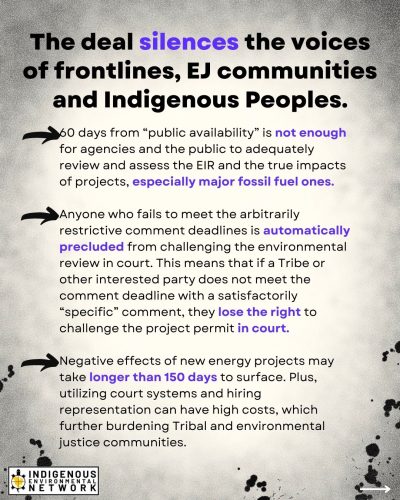
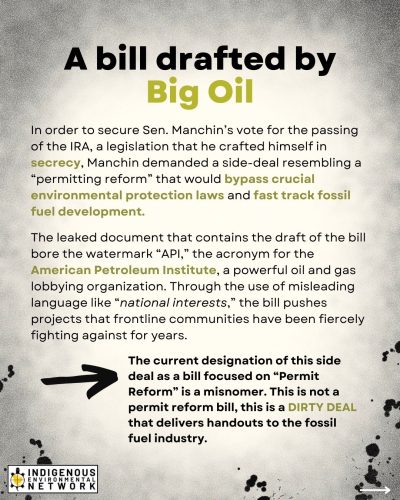
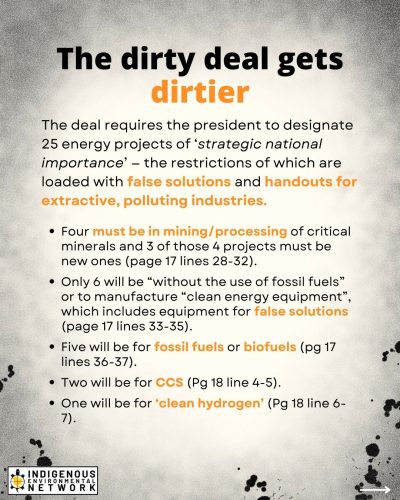
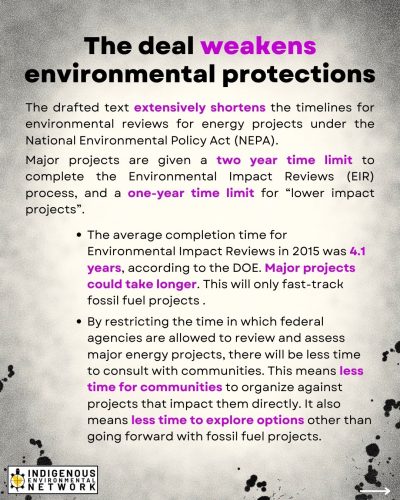
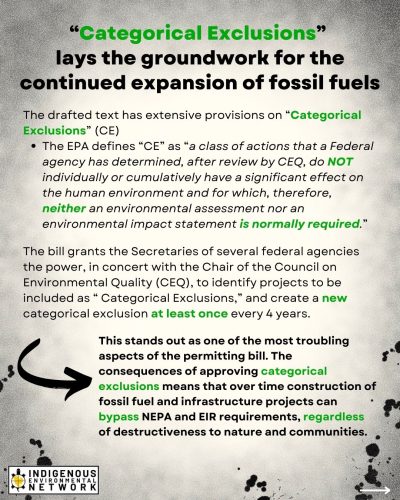
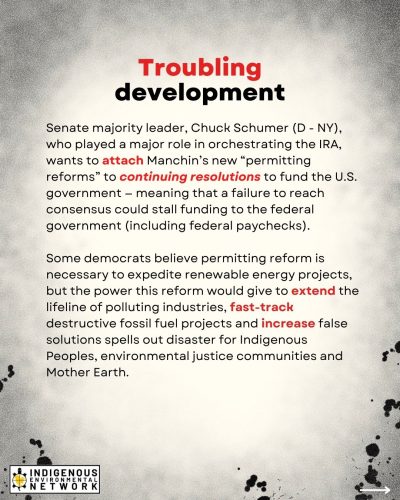
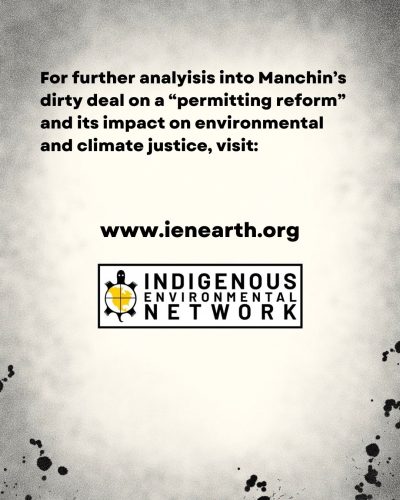
IEN Statement and Key Points on the “Permitting Reform Bill”
22 AUG 22
Last week, the so-called “climate bill” known as the Inflation Reduction Act (IRA) was signed into law by President Biden. In exchange for Senator Joe Manchin’s (D – WV) support for the bill, the IRA gave many handouts to the fossil fuel industry, including a dirty side-deal to expedite new dirty energy projects. Among the many concerns in this side deal are the threats facing Indigenous Peoples as provisions to weaken two landmark environmental acts, the National Environmental Policy Act (NEPA) and the Clean Water Act (CWA), that would fast track extractive developments impacting Tribal land. Indigenous lands, livelihoods, and communities are at stake.
The current designation of this side deal as a bill focused on “Permit Reform” is a misnomer. This is not a permit reform bill, this is a DIRTY DEAL that delivers handouts to the fossil fuel industry.
The dirty deal requires the president to designate 25 energy projects of ‘strategic national importance’ — the restrictions of which are loaded with false solutions and handouts for extractive, polluting industries. At a time when climate action to keep fossil fuels in the ground is at its most pressing, this bill would ensure the future of the fossil fuel industry at the expense of Indigenous Peoples and frontline communities. The first draft of this dirty deal was literally written by the American Petroleum Institute, which represents the interests of the oil and gas industry.
Now, senate majority leader Chuck Schumer (D – NY), who played a major role in orchestrating the IRA, wants to attach Manchin’s new permitting reforms to continuing resolutions to fund the U.S. government — meaning that a failure to reach consensus could stall funding to the federal government (including federal paychecks). Some democrats believe permitting reform is necessary to expedite renewable energy projects, but the power this reform would give to extend the lifeline of polluting industries, fast-track destructive fossil fuel projects and increase false solutions spells out disaster for Indigenous Peoples, environmental justice communities and Mother Earth.
The permitting bill was created to speed up the fossil fuel industry and benefit the profiteers that have contributed most to the climate crisis. Giveaways to the fossil fuel industry that bury any chance at consent like this one are no way to face the climate emergency! The only way forward is by promoting REAL solutions—we must kill this bill!
Below is a non-exhaustive list of key areas of concern in the “Permitting Bill”:
SECTION: STREAMLINING PROCESS FOR AUTHORIZATIONS AND REVIEWS OF ENERGY AND NATURAL RESOURCES PROJECTS.
- This section aims to make the process of reviewing and permitting energy projects faster despite risks of ineffective and poor assessments of environmental and justice impacts.
- The energy projects/constructions that this provision is looking to expedite are mainly infrastructures that
(ii) capture, remove, store, or transport energy (meaning Carbon Capture Utilization and Storage, Carbon Capture Storage, Carbon Dioxide Removal, and other false solutions).
(iii) mine, extract, beneficiate, or process minerals (meaning the continued extraction and use of fossil fuels).
(c) Lead Agencies
- The “lead agency” for new energy projects is required to take whatever necessary steps to cut short the environmental review process for projects. The “lead agency” is also only given a mere 45 days to identify and contact all other agencies. Tribal Nations and governments that have authorization over the project or site of the project to be a part of the decision making process.
- This is an invitation to omit Tribal and local agencies from the table by imposing a 45 day deadline.
(g) Coordination and Scheduling:
- (1) COORDINATION PLAN: Major projects are given a two year time limit to prepare Environmental Impact Statements, and a 1 year time limit on providing an Environmental Assessment.
- The average completion time for Environmental Impact Reviews in 2015 was 4.1 years, according to the DOE. Major projects could take longer. This will only fast-track fossil fuel projects .
- By restricting the time in which federal agencies are allowed to review and assess major energy projects, there will be less time to consult with communities. This means less time for communities to organize against projects that impact them directly. It also means less time to explore options other than going forward with fossil fuel projects.
- For NEPA, the shortened timeline means processes may need to limit their thoroughness, cut or trim certain reviews, or reduce the public’s ability to comment.
- The lead agency is only given 90 days to establish a complete plan for coordinating public and agency participation in, and comment regarding the environmental review process and authorization decisions for projects.
- Some agencies lack funding and resources, this time period will not be enough to create a well-thought out and adequate plan to coordinate with the public, especially EJ communities and Indigenous Peoples, whose land is most at risk of being impacted by these projects.
- (2) COMMENT DEADLINE: “Agencies” (including Tribal governments and local agencies) and the public are given 60 days to comment on the draft of the environmental impact statement beginning on the date it becomes publicly available. To make matters worse, the comment timeline is shortened to 30 days for a completed EIR and Federal authorization.
- 60 days from “public availability” is not enough for agencies and the public to adequately review and assess the EIR and the true impacts of projects, especially major fossil fuel ones.
- This imposition of an unreasonable deadline is a tactic to silence dissent and an absolute joke and insult to EJ communities to participate in the authorization and comment processes.
- Anyone who fails to meet the arbitrarily restrictive comment deadlines is automatically precluded from challenging the environmental review in court. This means that if a Tribe or other interested party does not meet the comment deadline with a satisfactorily “specific” comment, they lose the right to challenge the project permit in court.
(k) Efficiency of Claims:
- Any claims against new energy projects that seek a judicial review must file within 150 days of the project’s authorization under law.
- This is problematic because negative effects of new energy projects may take longer than 150 days to surface. Plus, utilizing court systems and hiring representation can have high costs, which further burdening tribal and environmental justice communities.
(o) Development of Categorical Exclusions
- This section of the bill grants the Secretaries of several federal agencies (USDA, DOI, DOE, etc.) the power, in concert with the Chair of the Council on Environmental Quality (CEQ), to identify projects to be included as “ Categorical Exclusions,” and create a new categorical exclusion at least once every 4 years. This would then bypass the requirement for an Environmental Impact Review and accelerate the delivery of a project.
- The EPA defines “categorical exclusions” as a class of actions that a Federal agency has determined, after review by CEQ, do not individually or cumulatively have a significant effect on the human environment and for which, therefore, neither an environmental assessment nor an environmental impact statement is normally required.”
- This stands out as one of the most troubling aspects of the permitting bill. The consequences of approving categorical exclusions means that over time construction of fossil fuel and infrastructure projects can bypass NEPA and EIR requirements, regardless of destructiveness to nature and communities.
SECTION: PRIORITIZING ENERGY PROJECTS OF STRATEGIC NATIONAL IMPORTANCE.
Requires the president to prioritize 25 energy projects (of ‘strategic national importance’). The breakdown of these 25 projects is extremely worrisome.
- Four must be in mining/processing of critical minerals and 3 of those 4 projects must be new ones (page 17 lines 28-32).
- only 6 will be “without the use of fossil fuels” or to manufacture “clean energy equipment”, which undoubtedly includes equipment for false solutions (page 17 lines 33-35).
- Five will be for fossil fuels or biofuels (which are of course still harmful) (pg 17 lines 36-37).
- Two will be for CCS (Pg 18 line 4-5).
- One will be for ‘clean hydrogen’ (Pg 18 line 6-7).
SECTION: EMPOWERING THE FEDERAL PERMITTING IMPROVEMENT STEERING COUNCIL AND IMPROVING REVIEWS.
(a) Definitions of Covered Project
- Adds “critical mineral mining” to the list of covered projects under the Federal Permitting Improvement section of the FAST Act.
- Reduces eligibility for projects related to energy construction, production, transportation, or storage to projects greater than $50 million, rather than $200 million.
(c) Mandatory Funding
- The Environmental Review Improvement Fund is given mandatory funding of $20 million each year from 2022 – 2026.
SECTION: STATE CERTIFICATION UNDER THE CLEAN WATER ACT.
(a) State Certification:
- Licenses or permits for projects that comply with the Clean Water Act must be granted within one year of receiving the application.
- Short time window for assessing and approving the environmental impacts on waters.
SECTION: TRANSMISSION.
(a) Ensuring an Abundant Supply of Electricity
- Allows energy transmission facilities to be constructed or modified if they are in the national interest. “National interest” can be determined by the Sec. of Energy, and includes areas that 1) experience congestion due to high energy consumption, 2) enhance energy independence, 3) are in the interest of national energy policy, 4) enhance homeland security, 5) enhance facilities that generate energy to the grid, 6) maximize energy rights-of-way, 7) avoid and minimize, to the maximum extent practicable, and offset, to the extent appropriate and practicable, sensitive environmental areas and cultural heritage sites, and 8) reduce electricity costs.
- This is problematic because energy transmission facilities (which can include infrastructure, physical structures, transmission lines, equipment, etc.) from various forms of energy generation are green lighted if they fall under one of the 8 categories of “national interest.” This could impact electricity generation on, or passing through, Indigenous lands and sacred sites.
To learn more and/or discuss how your tribal nation/organization can get involved to fight this dirty deal, please contact:
Joye Braun: joye@ienearth.org
Dallas Goldtooth: dallas@ienearth.org
###
